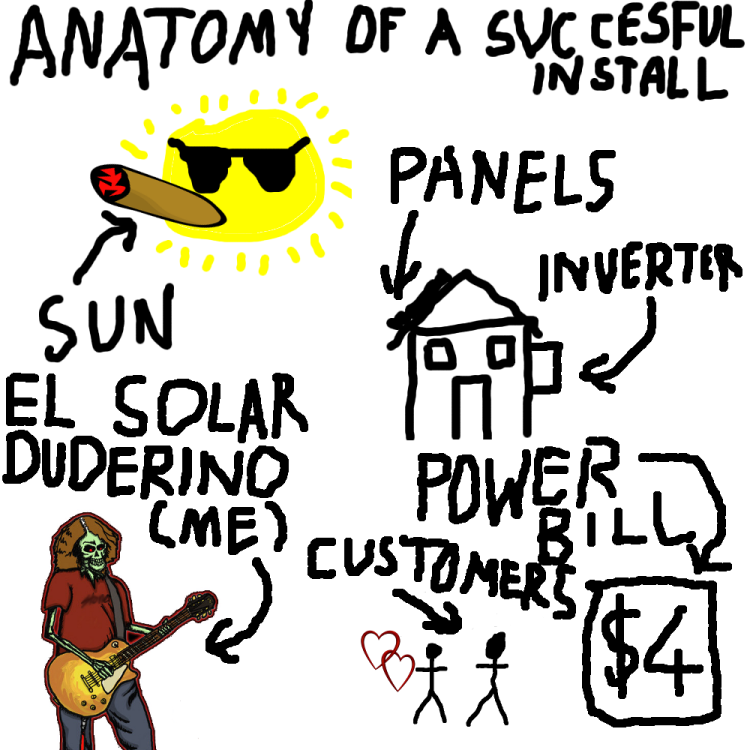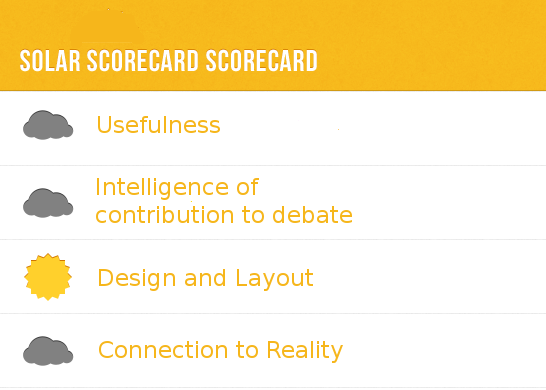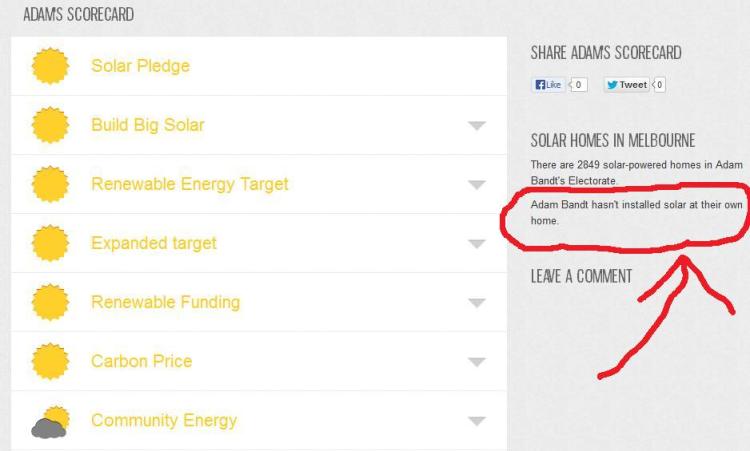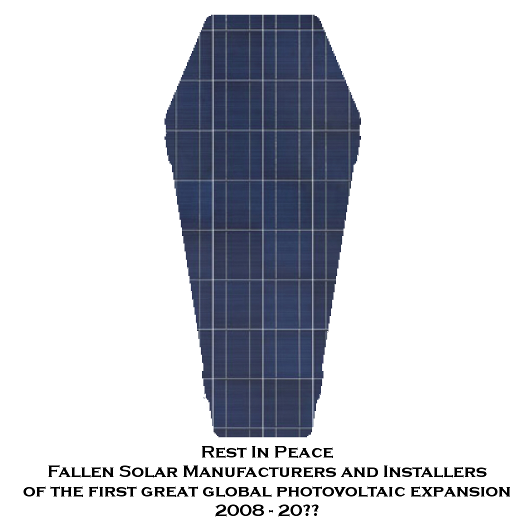Earlier this week a friend sent me yet another link about some spectacular innovation in photovoltaics and I immediately wanted to vomit. Friends and associates assume that El Solar Duderino spends his day wetting his pants over the next wondrous solar breakthrough right around the corner. Not true. Individually, a lot of these stories are an interesting distraction from my real work, but collectively they just shit me to tears.
This probably sounds mean spirited. All these scienticians and researchoids work their butts off to make the world a better place. Before you decide I’m just being a dick (again), hear me out.
My problem is not with the dudes in white coats busting their collective backside in the lab, and it’s not with the doo-hickeys they’re working on either. I dig doo-hickeys. I’m a doo-hickey friendly kinda guy. I own a doo-hickey purveying business. All things considered, I’m actually rather proud to take a doo-hickey positive approach to life. I really take no issue with brilliant minds and the undertakings they’re applied to – I love that shit. It’s the rest of you that need to pull your bloody heads in.
Way too many of you are spending way too much of your spare time popping science boners over things aren’t really things yet. It’s a total drag for a dude like me who has a pretty good idea how well you can get all the things you could want from a solar install just by using gear that, umm, actually exists.
Why are so many of you so hopelessly obsessed with what could possible in a few years time, that you totally ignore the extraordinary opportunities available right now? This is so painful to watch. It’s like seeing you daydream about how nice it would be to have a shot with Miss December, paying no regard to the fact that Miss August has been repeatedly texting you all night to tell you she’s feeling really vulnerable right now, oh and by the way she accidently just purchased way too much gourmet pizza and belgian ales, more than enough even for two hungry people really, and now that she’s all alone with it she’s really worried about what kind of career implications these diet choices could have for a nude centrefold, so she’d be really really grateful if you could come over right now to help save her from having all of it to herself and then you could both, you know, maybe hug a bit and “watch a movie” together. Come on guys. Take the hint. How good does the story have to get before you’ll contemplate making your move?

There’s an idea that floats around that being involved in solar installs means being involved in the bleeding edge of scientific and technical advances. That’s just not true – it’s not true of Excellence Solar, and it’s not true of our competitors either. I mean, I’ll grant you that this is some truly space age shit we’re putting on your roof, but the space age happened in the 1960s. That’s where this tech first got its legs: the very first application for photovoltaics was on American spaceships. Remember the Pioneer missions? Yeah, me neither. That all happened well before I was born.
A few months ago I did an interview with Rob Beckers on the Excellence Solar blog – Rob’s a Dutch-Canadian engineer, businesschap, and all-round rad dude who has a wind and solar installation enterprise in Ottawa called Solacity, and also hosts the Green Power Talk forums. During the interview I asked him a question about all the advances happening in solar power and he pulled me up and corrected me. “Actually technology has changed very little in the last several decades” he replied, and he’s exactly right. When I asked about advances is solar power, I kinda just meant that manufacturers are cramming more watts on to the same sized panel now and you can also connect some inverters up to your wireless network and then check how well the system’s doing on your mobile phone, but Rob’s words are better: they’re clearer and they impart more truth.
If a solar dude from the ’80s was woken tomorrow from a 25 year coma, or reheated after spending the same length of time in some Fry-from-Futurama frozen stasis, there’d be two things about the world today that would seem completely familiar to him: Tattooed 19 year old chicks who’ve ruined their hair by dyeing it too often still want to blow Nikki Sixx and rooftop solar installs still consist of crystalline panels, a solar inverter, sometimes some batteries, and after that it’s just a bit of stuff to hold the gizmos in place and connect them together.
The bit that’s gonna make hypothetical reheated 80s solar dude’s eyes pop about today’s installs is not the gear used, it’s the dollar figures attached to them. Hypothetical reheated 80s solar dude is not used to a world where installing solar is more affordable than not installing solar. El Solar Duderino contemplates his postulated unfrozen historical counterpart and doesn’t envy the job he would have had in selling a system back in those ancient, pre-stasis days. It’s not impossible to sell something vastly more costly than the conventional approach: brands like Maserati and Ritz-Carlton totally rely on it. Not everyone is counting their pennies. To sell people on a super expensive alternative, you have to find the people happy to part with the money for it, and then appeal largely to fairly amorphous benefits like ego, novelty, experience, benefaction, prestige, noblesse oblige, and so on. But mostly people didn’t sell systems in the 80s, and you can see that in the installed capacity figures. It’s pretty hard to sell people on the experience advantages of something that works by being totally unnoticeable as you go about your day. A quarter-century later, my job is so much more straightforward. Once the customer has their head around how expensive it is to not go solar, the decision to go solar becomes pretty easy, and the rest is just a matter of working with them on the how and the when.
The story of solar’s march into the global mainstream over the past decade is not a story of scientific breakthroughs but of commercial ones. It’s a story of factories going up, improved production line processes, cut-throat competition, lower wage countries demanding their place at the table, vast new economies of scale and no small number of proddings and spurrings from governments. It’s about money. To some extent, the world’s gotten better at making the 1950s crystalline panel technology we’re all installing, but mostly it’s just gotten better at making it at the right price.
This is not to say that exciting breakthroughs heralded by news stories won’t ever find their way onto roofs and into houses, offices, warehouses and factories. They will take their time though. The bleeding edge of technological innovation doesn’t just wander out of the lab, wave goodbye to the guys in the white coats and immediately start inhabiting products on the shelf that you can buy that very instant. Commercialisation of research is a long, expensive and inherently speculative process. First somebody needs to develop this research into something that could go onto a product, and somebody needs to come up with processes to create the stuff that make sense in a large scale profit-driven industrial environment. There’s a whole ‘D’ side to R&D. From there a manufacturer builds prototypes, and they get tested. None of this is instant, and then there’s no guarantee that the prototypes will work as expected, and even if they do, there’s no guarantee that the dudes in charge will decide that it makes commercial sense. Once the new tech is finally available in an off-the-shelf product, it will take a little while to not cost ludicrous bucks, so if you’re not happy to pay the early adopter tax then wait another few years.
How long does this all take before the lab result finally becomes something everyone’s installing? It’s kind of hard to say, because over the past 55 years of photovoltaics it’s mostly never happened. As far as it goes regarding major changes in the panels that actually see widespread use, polycrystalline panels became a strong option, without ever completely replacing monocrystalline panels, and that’s all that there’s really been. Thin-film spent a long time poised to be the rad new shit that would outcompete monocrystalline and polycrystalline panels purely on price, but crystalline panel makers flipped the script on this story and became even cheaper yet. Thin-film makes good sense in certain circumstances, like on calculators, but as something that you’d actually want to put on the roof it has yet to prove itself as a stronger option than crystalline panels in most parts of the world.
What we do have a good idea of is how long it will take for a system you buy today to pay for itself. There’s a little thing we refer to in the solar game called the “payback period”. This phrase is not unique to this industry but we use it a lot. The payback period is just the length of time it takes to get more savings from your system than it cost you to install it. This varies depending on your per-unit electricity costs, how fast those costs are going up, the layout of your roof, what feed-in tariffs are available to you, your daytime/nighttime electricity usage mix, how well your currency is doing, how long you’re left waiting for the install to be completed, and how good a deal you get from your installer. Excellence Solar customers get great deals and our installs happen lightning fast, so these systems don’t take too long to pay for themselves. With Melbourne’s electricity prices rising so fast, the 5kW system you see in that link there will pay for itself in under 4 years. We also sometimes talk about a system’s embodied energy payback period, which is a similar kind of thing, except instead of talking about money, it refers to how long it takes for the system to provide more energy than was expended to build and install it. If your reasons for going solar involve some element of being kinder to the planet, this metric should be important to you. The figures on how much energy goes into a system are rather less transparent than some people like to pretend, but speaking very broadly, this length of time is usually similar to but slightly shorter than the financial payback period.
Why is all this talk about payback periods relevant to a discussion about scientific breakthroughs? Because a system we install within the next couple of weeks will have easily paid itself off before the news story you’re linking me to has become something you can buy. A rich uncle could swoop in and buy you a system built from this amazing new tech the minute that it’s available, and you’d still be behind financially on where you’d be if you’d bought a system today with your own money.
The thing you have to ask yourself is “What do I want from going solar?“. It might seem like an overly obvious question, but when people salivate over scientific breakthroughs they’re totally avoiding it. There’s no end of oddball ways you could approach this question. Maybe you think that having panels will make it harder for the illuminati to use their spy satellites to read your thoughts, or perhaps you just get a kick out of adding things to your roof, or likelier yet you just secretly think El Solar Duderino is really witty and handsome and so you just want to do things that will make him like you more. The real answer for 99% of you, however, is “I want to start making my own electricity“. This leads to benefits like “my power bills are almost/totally gone“, and “my ongoing electricity use creates few/no carbon emissions now“.
These features and benefits are available from an install right now. You don’t need to wait for something else to happen. Installing is already less expensive than not installing. You don’t need to pin your hopes on vaporware.
You might retort that if you hold off to get an install, then you’ll be able to get something way better down the track. The question you’ve gotta ask yourself here is this: “How much am I going to spend on power bills over the next decade while I’m waiting for lab results to become products?” Electricity costs vary massively around the world, so the answer to this won’t be the same for everyone. If you’re from Australia, the answer is gonna be “a lot more money than what it’d cost me to get a system installed within the next few weeks that would cover most or all of my electricity needs“. Sure, you might be able to buy something a bit more whizzbang than what’s available right now, but you’ll also be out of pocket for the full cost of a system without actually getting to own one. Why are you so keen to pay more than the cost of a system, just to be left holding nothing at the end, with bills coming in that are bigger than ever?
What’s so great about paying bills that you’re not ready yet to say goodbye? Is someone from your utility company making a discrete visit every six weeks to orally pleasure you, on the understanding that they will always provide 100% of your electricity? If that’s what’s going on then I need to rethink my whole approach to business.
By all means, be interested in the exciting possibilities the future might contain. But stop treating rooftop solar as a technology of the future. It’s here already and it we don’t need anything new for it to make perfectly good sense.
Interest in other categories of tech product is rarely characterised by such an extreme overfocus on stuff you can’t have. Nobody keeps in touch with friends using two tin cans and a taut length of string because they’re holding out for the iPhone 9. Console gamers are definitely keen to hear about products in development, but only after they’ve killed a few bad guys on their PS3 or spent time on the Xbox Live Network being regaled with fascinating tales by American teenagers claiming intimate knowledge of everyone’s mother. I personally still hold on to my PS2, because I have this weird idea that GTA: Vice City represents the pinnacle of 21st century video games, although secretly I just miss my Mega Drive. I should have never sold that thing.



